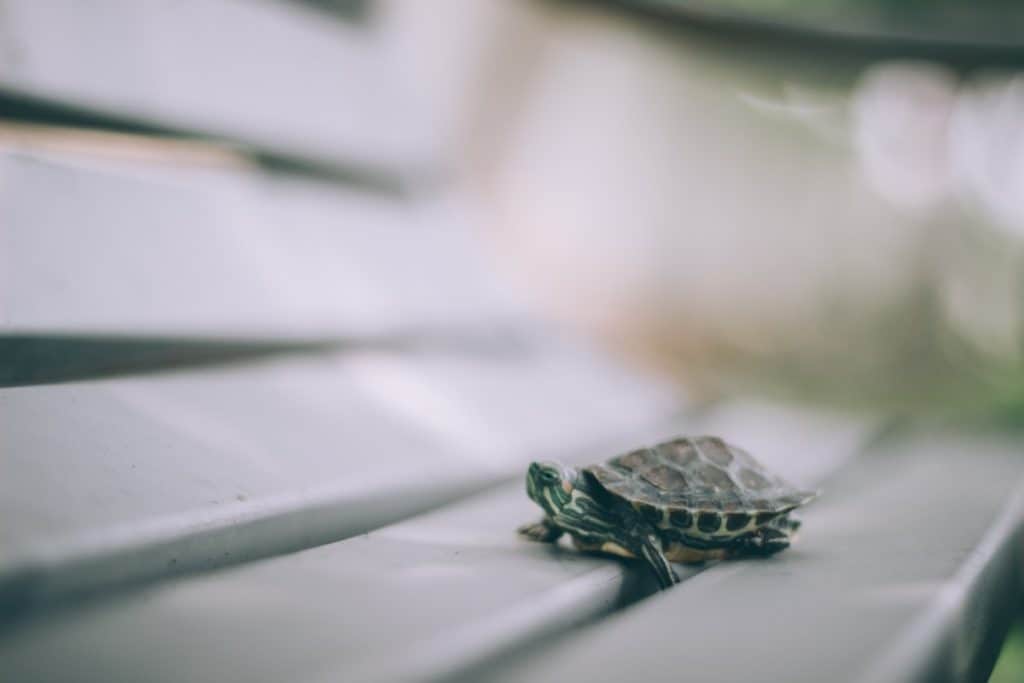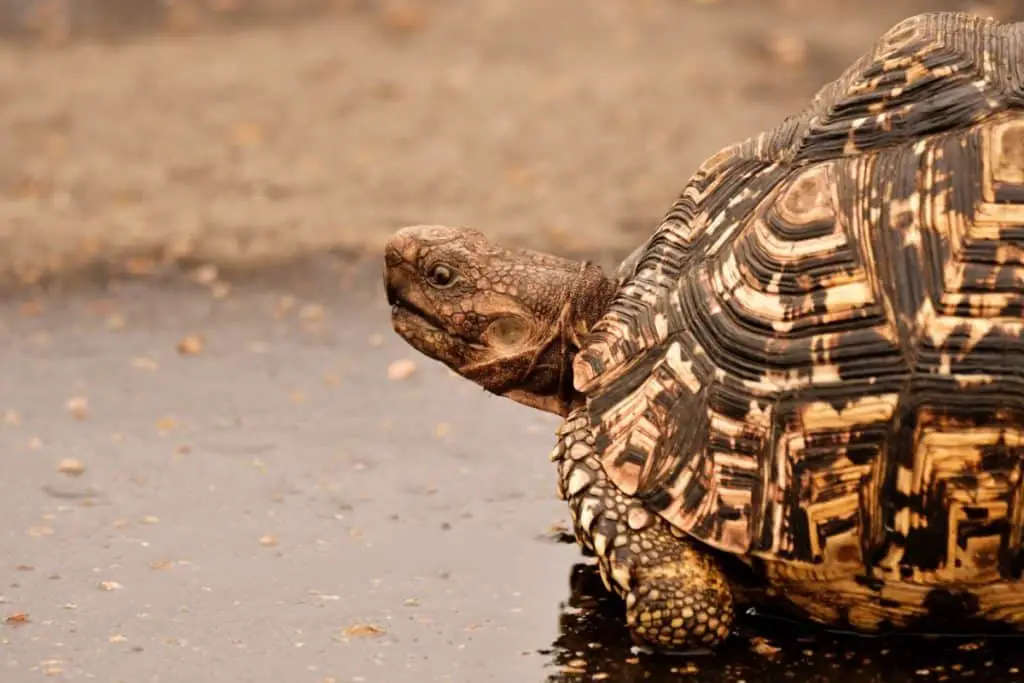
If you are interested in finding out whether a turtle is a producer, a consumer, or a decomposer then you’ve come to the right article.
As, in this article, you’ll find the exact answer to this question, and also after you’ve read the answer to the main question then I’ll cover the answers to a few more closely related questions as well to extend your knowledge further.
I hope you learn a lot from this article.
Is a Turtle A Producer, A Consumer, Or A Decomposer?
Turtles are consumers because they do not produce food like plants.
Nor do they feed on decomposing matter.
There are many different species of turtles, and they don’t all eat the same diet, but they all consume food produced by their environment.
The diet of a marine turtle primarily consists of algae, seaweed, shrimp, crabs, mollusks, sea squirts (tunicates), and soft-bodied jellyfish.
Most turtles are omnivorous.
They eat plants (producers) and small herbivorous animals (primary consumers) as part of a mixed diet.
Some types of sea turtles have species-specific habits.
For instance, green turtle hatchlings start life omnivorous but grow up to be almost entirely vegetarian.
Loggerheads, on the other hand, start life as omnivorous hatchlings but mature into mostly carnivorous turtles that crush crabs and whelks in their powerful jaws.
Is a Sea Turtle A Producer, A Consumer, Or A Decomposer?
Sea turtles spend their lives in the water.
But other turtles (such as the Box Turtle or terrapin) can survive on land as well if they still have access to water.
This is the primary difference between aquatic and terrestrial turtles.
Both species are consumers in their respective food chains, sea turtles and terrestrial turtles get essential plant nutrients by eating animals (consumers) and producers (plants).
Sea turtles do not produce their food via photosynthesis so they are not considered producers.
Nor are they decomposers like bacteria and fungi which harvest nutrients from decomposing organic matter.
Sea turtles find all their food in their environment.
Check out the video below if you want to see a sea turtle devour a jellyfish, like spaghetti.
Is a Snapping Turtle A Producer, A Consumer, Or A Decomposer?
The ferociously named snapping turtle primarily eats insects, crayfish, snails, minnows, and some types of aquatic plants such as seaweed and algae.
For this reason, the snapping turtle is considered a consumer in its food chain rather than a decomposer (bacteria, fungi) or a producer (plant life).
The Snapping Turtle is a consumer because it survives by eating food produced by its environment (like, for example, plants, fish, and small invertebrates).
The species is often described as an opportunistic omnivore which is an animal that will eat almost anything it finds in its environment.
The larger the turtle, the easier it can take down prey so bigger turtles tend to be more carnivorous.
Some Snapping Turtles even hunt small birds and most would feed from nearby carrion if an opportunity arose.
Is a Painted Turtle A Producer, A Consumer, Or A Decomposer?
The Painted Turtle is a consumer within its food chain because it does not produce food via photosynthesis as plants do (producer) nor does it break down decomposing matter (decomposer) to create food.
It sources all of its dietary sustenance from its external environment in the form of insects, tadpoles, crayfish, crustaceans, and worms.
Painted Turtles are omnivorous animals that will also eat plant matter when available.
This makes them both primary and secondary consumers.
Sometimes they consume producers (plants).
Other times they survive by eating primary consumers (small herbivorous animals).
Because of their small size, Painted Turtles rarely get to eat secondary consumers unless there’s a carrion opportunity nearby.
They cannot be considered tertiary consumers like some larger, more aggressive species.
Is a Green Turtle A Producer, A Consumer, Or A Decomposer?
Like all other terrestrial and sea turtle species, Green Turtles are consumers.
Unlike decomposers, they do not create food from dead matter.
And they cannot produce their food as food chain producers (plants) do.
Instead, Green Turtles source all their sustenance from their environment by eating plants and other animals.
This species is unusual because it’s the only sea turtle to subsist on an almost entirely vegetarian diet.
Green Turtles eat mostly algae and seagrasses though they will consume invertebrates, soft-bodied sponges, and even carrion if their preferred food sources are unavailable.
So it’s technically not accurate to call the Green Turtle a herbivore.
For most of its life, the species is a primary consumer (plant eater) but, in some circumstances, it is also a secondary consumer (omnivorous).
Check out the video below if you want to see a green turtle feed on some seagrass.
Is A Turtle A Primary Consumer?
All turtles, terrestrial and aquatic, are food chain consumers but not all turtles are primary consumers.
Turtles can be primary, secondary, or even tertiary consumers depending on their species, physical capabilities, and natural environment.
Sometimes, size plays a part in determining what types of food a turtle can access.
Larger species such as the Alligator Snapping Turtle and Loggerhead Turtle, while not exclusively carnivorous, have the size and speed to hunt and kill small herbivores and even some meat-eating organisms.
They are sometimes secondary consumers and sometimes tertiary consumers when the opportunity arises.
The majority of turtle species are secondary consumers, opportunistic omnivores that eat whatever they can find in their natural environment.
This includes insects, worms, small fish, jellyfish, soft-bodied sponges, crabs, crustaceans, tadpoles, seaweed, and algae.
They are sometimes primary consumers (herbivores) but mostly secondary consumers (omnivores).
There are no true primary consumers (herbivores) among wild turtles.
No wild turtle is exclusively vegetarian.
The closest is the Green Sea Turtle which subsists on a largely vegetarian diet of seagrass and algae.
Yet, even Green Sea Turtles are known to eat sea sponges and jellyfish when available making them primary consumers just some of the time.

Is A Tortoise A Primary Consumer?
Wild tortoises were once thought to be true primary consumers, exclusively vegetarian land mammals with a plant-based diet consisting of leaves, grasses, fungi, fruits, and vegetables.
However, recent research has revealed that these slow-moving animals have a decidedly opportunistic streak.
While almost entirely herbivorous (primary consumers), tortoises are known to eat worms, insects, shellfish, and carrion when available.
One large tortoise was even caught on camera preying on a juvenile bird.
So tortoises can be opportunistic secondary consumers but they prefer eating vegetarian foods.
Is A Snapping Turtle A Secondary Consumer?
The Snapping Turtle is one of the largest freshwater turtle species in the world, a formidable creature with exceedingly powerful jaws and a preference for frogs, crayfish, snakes, fish, worms, and even some small mammals.
Snapping Turtles have been observed hunting and eating other small turtles and consuming carrion when available.
This species is an opportunistic hunter with a largely (but not exclusively) carnivorous diet.
Snapping Turtles are primarily secondary consumers (small animal eaters).
They like to eat meat but around a third of their diet consists of plant-based foods.
So it’s more accurate to describe them as omnivorous.
In some rare circumstances, they may also be tertiary consumers because they have the potential to kill larger meat-eating organisms like snakes.
Is a Turtle A Tertiary Consumer?
There are many different species of turtle, including sea and terrestrial varieties, and they all have slightly different diets.
The majority of wild turtles are secondary consumers as they consume both animals (primary consumers) and plants (producers), thus making their diets omnivorous.
However, some turtles like Snapping Turtles eat more animal flesh than others and are even capable of stalking and killing other omnivores (secondary consumers) such as snakes, frogs, and fish.
These turtles are opportunistic tertiary consumers but even their diet is largely made up of herbivorous animals, rather than larger meat-eating organisms, so they are secondary consumers most of the time.
Is A Sea Turtle A Tertiary Consumer?
All turtle and tortoise species have an opportunistic streak when it comes to food.
Even the slow-moving land tortoises we once thought were vegetarian are now known to consume animals on occasion.
And sea turtles are no exception.
Even the closest to a vegetarian sea turtle, the Green Sea Turtle, is not vegetarian all the time.
The same can be said of carnivorous sea turtles such as the Loggerhead.
Loggerhead turtles love to eat crabs, whelks, and conches and are largely carnivorous but not exclusively.
They consume algae, seagrasses, and soft-bodied sponges on occasion.
Just like the Green Sea Turtle, their diet can vary making it most accurate to call them secondary consumers or omnivores.
Larger, more powerful sea turtles, like the Loggerhead with its powerful jaws, are tertiary consumers just some of the time.
However, this is usually due to opportunistic hunting and most don’t eat enough secondary consumers (omnivores) to be called true tertiary consumers.
Is A Turtle A Quaternary Consumer?
Turtles may be primary, secondary, and tertiary consumers depending on their circumstances and available food resources.
However, they are not quaternary consumers.
Even the largest turtles lack the speed and power needed to hunt highly predatory tertiary consumers like barracudas, sea lions, or sharks.

Is A Turtle A Herbivore?
It was once thought that some land turtles were true herbivores who never consumed animal proteins.
However, recent research has revealed that even the slowest species will kill or scavenge other animals if given the opportunity.
The only true vegetarian turtles are likely those in captivity being fed exclusively vegetarian diets.
Turtles can easily subsist on nothing but plant-based foods but most wild turtles, aquatic and terrestrial, will eat meat on occasion.
Turtles are opportunistic eaters.
Is A Sea Turtle a Herbivore?
The Green Sea Turtle is the closest turtle species to being truly herbivorous as its preferred foods are seagrasses and algae foraged from coral reefs.
However, even this species is known to consume insects, worms, and crustaceans on occasion.
There aren’t any strictly herbivorous species of aquatic turtles.
So it’s more accurate to describe sea turtles as omnivores or secondary consumers.
Some larger species are also tertiary consumers if the opportunity to kill a meat-eating animal (like, for example, sea snakes, fish, or crabs) arises.
Is A Turtle A Carnivore?
Just as there are no strictly vegetarian turtles, no species of turtle is exclusively carnivorous though some are surprisingly adept hunters.
Loggerhead turtles and Snapping Turtles are probably the closest to being fully carnivorous but even they supplement their diet with seagrasses, sponges, algae, fruits, and vegetables when available.
It’s more accurate to describe wild turtles as omnivorous organisms.
Is A Turtle An Omnivore?
Though some turtle species primarily eat vegetation and other species eat hardly any plant-based foods, all turtles (aquatic and terrestrial) are willing to consume some plants (producers) and some animals (primary and secondary consumers).
It all depends on what constitutes the best food source in their environment.
Turtles are fantastic examples of opportunistic organisms.
So the most accurate way to describe them is as omnivores, hence secondary consumers.
